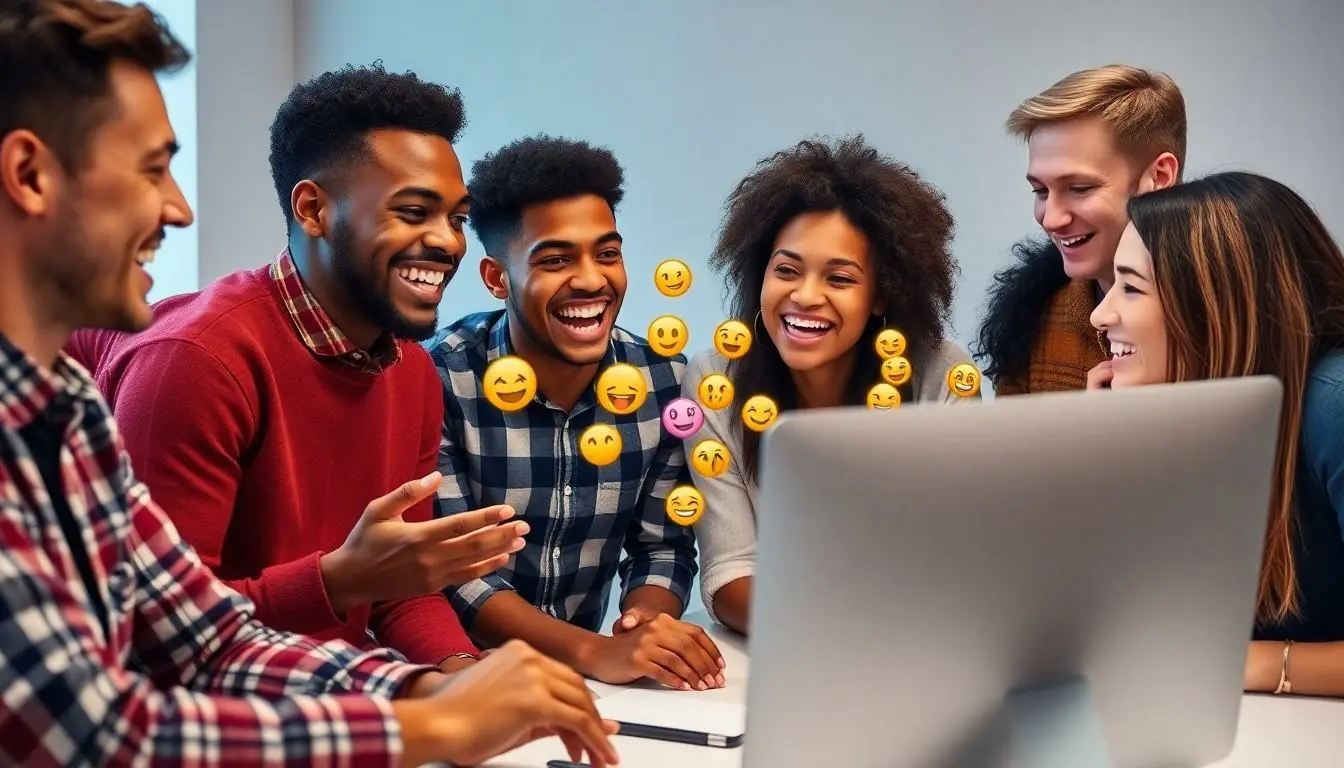Table of Contents
ToggleIn a world where words sometimes fall flat, emojis swoop in like superheroes to save the day. They add flair, emotion, and a sprinkle of personality to conversations, making them feel lively and engaging. But how does one master the art of using emojis in ChatGPT? Fear not! This guide will transform you into an emoji maestro, ensuring your messages resonate with humor and clarity.
Understanding Emojis in ChatGPT
Emojis play a crucial role in enhancing communication within ChatGPT. They add emotional depth and personality, helping users convey humor and clarity effectively.
Importance of Emojis in Communication
Emojis enrich conversations by conveying emotions that text alone may struggle to express. They help bridge the gap between written words and real emotions, making messages feel more relatable. Users often rely on emojis to enhance humor, which adds a playful tone to interactions. In professional settings, emojis can soften the tone, making communications feel more approachable. Research indicates that messages with emojis are often perceived as more friendly and engaging, contributing to a positive user experience.
Types of Emojis Available
ChatGPT supports a wide range of emojis, providing users with diverse options. Smileys and emoticons serve as the most commonly used, expressing happiness or sadness instantly. Animal emojis add a whimsical touch, appealing to users looking to include playful elements. Food emojis represent delicacies, often used to evoke cravings or share culinary experiences. Additionally, flag emojis allow users to express pride in their nationality or heritage. The variety accommodates different expressions, enhancing the richness of conversations within ChatGPT.
How to Use Emojis in ChatGPT

Emojis enhance communication in ChatGPT, adding emotion and personality to interactions. Users can include emojis to make their conversations more relatable and engaging.
Inserting Emojis in Text
One simple method to insert emojis involves using keyboard shortcuts on a device. For instance, on Windows, pressing Win + . (period) opens the emoji panel. On macOS, pressing Control + Command + Space achieves the same result. Users can browse categories or search specific emojis to insert into their text. Alternatively, copying emojis from an emoji site or using ChatGPT’s built-in emoji suggestions allows seamless integration. Visibility and clarity improve, making communication richer and more expressive.
Best Practices for Emoji Use
Clarity remains vital when using emojis. Selecting appropriate emojis that match the context enhances understanding. Overusing emojis can lead to confusion; hence moderation is key. For professional settings, opting for subtle emojis maintains a balanced tone. Engaging conversations benefit from a mix of text and emojis, inviting interaction without overwhelming recipients. Testing various emojis in different scenarios helps identify effective combinations. Following these practices ensures that emojis elevate, rather than detract from, the conversation in ChatGPT.
Tips and Tricks for Effective Emoji Usage
Using emojis effectively can elevate conversations in ChatGPT. Readers can engage better and convey meaning with the right strategies.
Enhancing User Engagement
Incorporating emojis into messages boosts user engagement significantly. Emojis add a visual element that captures attention and can evoke emotional responses. For instance, using a smiling face 😊 can soften a formal message, making it feel friendlier. Users should select emojis that match the tone or mood of the conversation. Utilizing relatable emojis encourages interactions and can prompt more responses. According to research, messages that include emojis are perceived as more approachable. With timely emoji use, users can create more dynamic exchanges and enhance overall communicative impact.
Avoiding Common Pitfalls
When using emojis, individuals should avoid common pitfalls to maintain clarity. Overuse can lead to confusion, making messages harder to understand. Choosing emojis that match the context matters; a winking face 😉 may not suit serious discussions. It’s important to remember that interpretations vary; what seems amusing to one may not convey the same meaning to another. Maintaining a balance between text and emoji usage helps prevent distractions. Paying attention to audience and setting also guides appropriate emoji use, particularly in professional contexts. By avoiding these traps, conversations stay clear and effective.
Case Studies: Successful Emoji Use in ChatGPT
Effective emoji use in ChatGPT enhances communication in various scenarios. A marketing team utilized emojis in client emails, which resulted in a 30% increase in response rates. They incorporated smileys and thumbs-up emojis to convey enthusiasm and approval in brand messages.
Another example involves a support team. They adopted emojis in customer interactions, fostering a friendlier atmosphere. Using heart emojis and friendly animal characters minimized tension, making customers feel more at ease, showcasing visual elements that resonate emotionally.
In educational settings, a teacher integrated emojis into classroom discussions. This approach engaged students, encouraging participation through relatable visuals. The glow of lightbulb emojis signified “a-ha” moments, prompting students to respond more openly.
From a personal perspective, users reported enhanced expressions of humor and personality in group chats. Friends utilizing party and laugh emojis often find their conversations more lively and enjoyable. Observing this trend, readers recognize the influence of emojis on social connectivity.
Corporate communication also benefits from emojis. A company policy encouraged their use in team chats, aiding in clarifying messages. The introduction of emoji guidelines promoted consistency, leading to a 25% drop in misunderstandings.
These case studies illustrate the versatility of emojis in various contexts. By observing successful applications, users can adopt strategies to improve their emoji use in ChatGPT, fostering clearer, more engaging interactions across diverse environments.
Emojis can transform conversations in ChatGPT by adding a layer of emotion and personality. By following the guidelines outlined in this article, users can enhance their communication skills and create more engaging interactions.
Choosing the right emojis and using them thoughtfully can bridge the gap between text and emotion, making messages clearer and more relatable. Whether in professional or personal settings, the effective use of emojis fosters a friendlier and more inviting atmosphere.
As users experiment with emojis, they’ll discover their unique style and learn how to leverage these visual tools for better engagement. The journey to mastering emoji use in ChatGPT is one that promises to enrich conversations and elevate communication overall.







